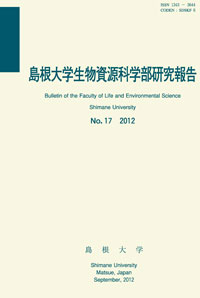島根大学生物資源科学部
ISSN:2435-0885(オンライン)
ISSN:1343-3644(冊子体)
なお、冊子体の刊行は23巻まで
ISSN:1343-3644(冊子体)
なお、冊子体の刊行は23巻まで

ダウンロード数 : ? 件
この文献の参照には次のURLをご利用ください : https://ir.lib.shimane-u.ac.jp/31302
島根大学生物資源科学部研究報告 19
2014-09-30 発行
頭足類生殖システムにおける代替的適応形質の制御基盤 : 総合的オーム解析
Regulatory basis of alternative adaptive traits in cephalopod reproductive systems : an integrative omics approach
ファイル
内容記述(抄録等)
In the coastal squid Loligo bleekeri, each male produces of two types of fertilization-competent spermatozoa ( eusperm ) that exhibit morphological and behavioral differences. Large'consort'males produce short-tailed spermatozoa that display free-swimming behavior when ejaculated into seawater. Small'sneaker'males, on the other hand, produce long-tailed spermatozoa that exhibit a self-swarming trait after ejaculation. To understand the molecular basis for adaptive traits employed by alternative male mating tactics, we performed the transcriptome deep sequencing ( RNA-seq ) and proteome analysis to search for differences in testicular mRNAs and sperm proteins, respectively. From mature male testes we identified a total of 236,455 contigs ( FPKM=1 ) where 3789 and 2789 were preferentially (>10-fold) expressed in consort and sneaker testes, respectively. A proteamic analysis detected 4302 proteins in the mature sperm as post-translational products. A strongly biased (>10-fold) distribution occurred in 55 consort proteins and 61 sneaker proteins. A family encoding dynein heavy chain gene, however, was found to be biased towards sneakers, whereas many enzymes involving energy metabolism were heavily biased towards consort spermatozoa. From these results we hypothesize that discrete differential traits in dimorphic eusperm arose from a series of innovative alterations in the intracellular components of spermatozoa.
About This Article
Other Article
